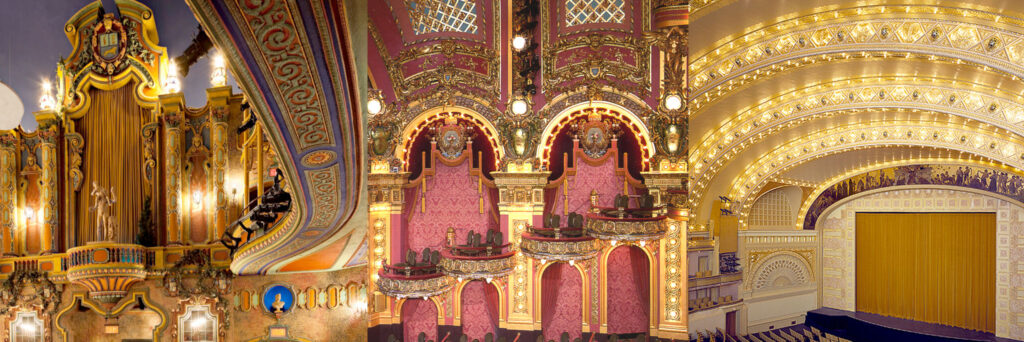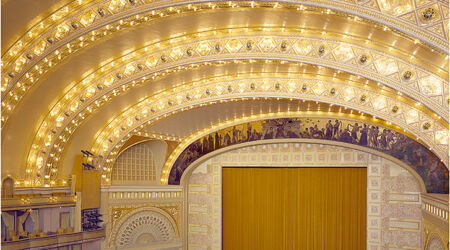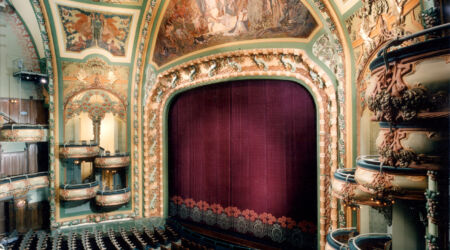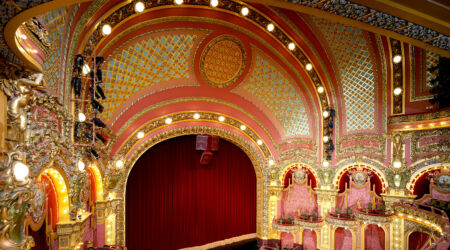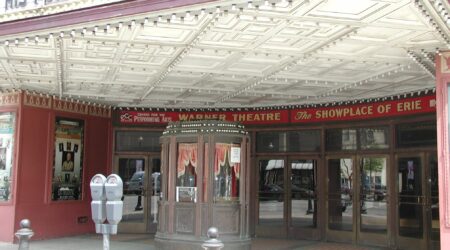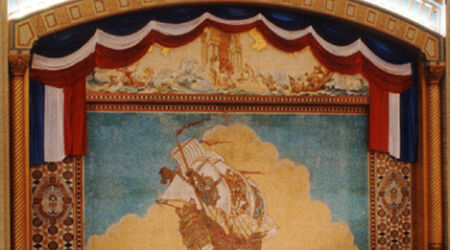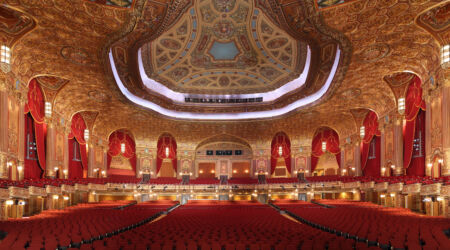People usually notice decorative painting and gilding of architectural elements as the most dominant aspects of theater finishes, but there are many more features that contribute to the distinctive style of each interior. A wide variety of textiles contribute to the overall appearance of theaters. These can include painted fire curtains, painted drops and advertising oleos, painted or embroidered applique decoration on draperies, lambrequins, screens, murals on acoustic fabric, painted silk, and scrim, upholstered or wall- mounted fabrics, carpeting, hung tapestries and more. As a restorer, EverGreene has often been presented with unique problems to solve concerning soft goods in historic theaters.
Advertising Oleos
Many types of painted stage curtains were produced during the last two decades or the nineteenth century up to the Second World War. Most curtains were painted by itinerant artists, scenery companies, and theater-arts studios, although a few were done by well-known mural artists such as Jules Guerin. Asbestos cloth was often used for painted curtains. Typically, proper encapsulation and cleaning are needed to meet environmental code. Occasionally an asbestos abatement contractor may have to be brought in to abate friable asbestos before handling by conservators. Not only fabrics are used as fire curtains.
The Auditorium Theatre in Chicago has a plaster reducer curtain in the proscenium, embellished with ornament designed by architect Louis Sullivan. A representative example of a painted asbestos fire curtain in terms of treatment, but extreme in term of size, is the fire curtain at the Atlantic City Convention Hall, painted by Novelty Scenic Studios in 1929. It’s the biggest historic painted curtain we’ve ever seen at 48 feet high by 109 feet wide.
The Atlantic City Convention Center has fabric is woven of asbestos fibers wound around a core of brass wire. Atypically, oil-based primer and paint were used for the scene of a sailing ship at sea, surrounded by a decorative border with patterns and colors that complement the decorative scheme of the Convention Hall’s proscenium and loggia. The central ship design was painted loosely with large brushes over a silver preparation, after which silver paint was splattered over to give the curtain a shimmering effect when viewed from a distance. A team of EverGreene technicians on scaffolding cleaned and conserved this large curtain in 200I as part of the historic rehabilitation of the Convention Hall; the scene is now a backdrop for a sports arena!
A lot of scenic or “oleo” curtains were originally executed in set painters’ glue distemper paint on muslin or heavy canvas; some interwoven with asbestos fibers. They often idealized rural scenes and scenic landmarks, or American, European, or patriotic historic scenes. At the Attucks Theatre (Norfolk, VA – 1919), the canvas stage curtain depicts the Boston Massacre, in which Crispus Attucks, a black seaman, became the first casualty of the American Revolution. Another example is the pictorial curtain designed by John Eberson at the Carpenter Center for the Performing Art (Richmond, VA). Both were conserved by EverGreene using the techniques described below. Very different from pictorial scenes of the late nineteenth century are wall murals in the Art Deco Style at the Palace Theatre (Cape Charles, VA) in which a stylized female figure and lush flora and fauna were painted on textured cotton fabric.
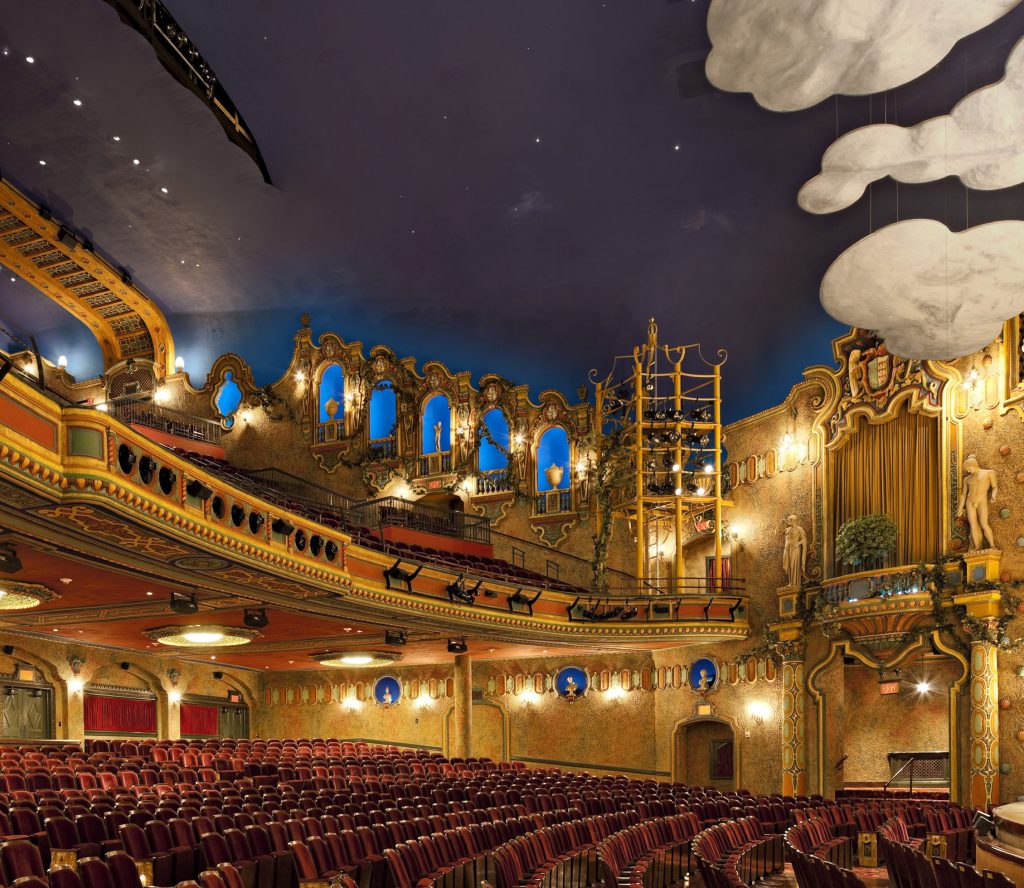
Conservation of Painted Stage Curtains & Decorative Textiles
Conserving an original curtain not only preserves a highly visible piece of theater history, but it is also a fraction of the cost of making a new one. Fabrication and decorative painting of a large fire curtain can cost in the $60,000 range, not including the cost of rigging. Usually, original curtains are in fairly good order. Typically, conditions include a coat of grime, areas of flaking paint and paint losses, water stains, scattered small tears, and frayed areas. Skills required to conserve and restore historic theater curtains include conservation of paint and textiles, hazardous materials training, and artistic abilities in pictorial and decorative painting.
The extent of construction work in a theater restoration sometimes leads to a decision to take down and store of encase a historic fire curtain to protect it. Proper conservation treatment, handling, and storage procedures and crucial to ensure that the fabric and its painted decoration will be intact when it is time to rehang. Planning should begin with the examination of conditions by a conservator who can make treatment recommendations and provide a budget. Steps may include encapsulation of asbestos fabric, dry cleaning by hand, consolidation of flaking paint, and mending of fabric. The curtain can then be rolled up with a special non-stick Ph neutral lining paper and padding, if necessary, to protect the painted surface, placed into a purpose-built container, and stored in an environment with controlled temperature and humidity.
“Just about any textile can be conserved,” says consultant Deborah Bede, formerly of Stillwater Textile Conservation Studio, “but the end-use has a big impact on the treatments we choose.” Ms. Bede points out that textiles in actively used public buildings are at risk from impact, touching, and variable environmental conditions, unlike textiles in controlled museum settings. “Sometimes making a replica is the right thing to do to protect a fragile original.” A flameproof backing is one way to keep and original textile in place, give it extra support, and meet code.
Replicating Designs
Painted decoration can be replicated on conventional fabrics. Elaborate embroidery or applique on stage curtains and other draperies are historic embellishments that are now prohibitively expensive to reproduce in kind. For Cleveland’s Palace Theatre artists developed a painting technique to simulate the large embroidered motifs on the original stage curtain. New York’s New Amsterdam Theatre has a stage curtain with stenciled Art Nouveau-style motifs that resemble the applique on the long-lost original curtain.
Archival photos of Boston’s Cutler Majestic Theatre at Emerson show that textiles were an important feature in the decor. But none of the original decorative valances. draperies, or upholstery survived. New drapery fabric, as well as fabric for upholstered handrails and capping, was selected by searching among suppliers for the best match to fragments of the original material. The side boxes at the Emerson Majestic were once elaborately draped with large embroidered valances that would be astronomically expensive to reproduce. Artists painted samples of the valance decoration on fabric to show how the effect could be created more economically.
The damask fabric on the walls of the Emerson Majestic was also long gone. But custom weaving, or purchase of similar damask, was beyond the client’s budget. EverGreene’s designers figured out the scale of the pattern using clues from archival photos, and with computer modeling, came up with several ways to emulate the pattern. Samples of the valance and wall covering were hung adjacent to the decorative painting mock-up for review of the total ensemble by the client. This is one of many theaters where the reproduction of fabric patterns using decorative painting techniques has been a viable solution.
At the Art Deco-style Warner Theatre (Torrington, CT1931), a very late Thomas Lamb design, fabric was a big part of the original decor, along with stencils made with unusual glitter paint. Copper-colored fake “monkey fur” on the walls had both aesthetic impact and acoustical properties. Staff searched for a year among wholesale fabric dealers and textile mills for matching or similar fabric. Custom dyeing a similar fabric was the client’s ultimate choice, with acoustical material installed behind it. In addition, tapestry fabric of the original banana-leaf patterned side draperies was shown to textile mills and identified as a frieze weave in a novelty boucle yarn, which could be reproduced in a flameproof material of the same texture and weight. The research for the Torrington Theatre proved useful in the study EverGreene did with Daniel P. Coffey & Associates for the Warner Theatre (Erie, PA-1931. Rapp & Rapp). Frieze weave fabric made with boucle yarn was used on the walls in Erie but in a different pattern. Both theaters decided to have custom replacement fabric woven.
Acoustical consultants and suppliers of acoustical fabric can provide helpful guidance on the selection of fabric and how to preserve its acoustical properties when painted. When EverGreene was asked to create a damask pattern on acoustical fabric for the Folly Theatre (Kansas City, MO), artists air-brushed paint lightly onto the open weave fabric to avoid having thick ridges of paint block sound transmission. Another application of this technique is at Town Hall in New York, where trompe l’oeil organ pipes were painted on acoustical fabric as a scrim over speakers installed in the loggia box organ chamber.
Another interesting example of the architectural role of textiles in different theaters is at the Art Deco-style Flynn Center for the Performing Arts (Burlington, VT-1930). The former organ chamber has an ornate screen backed by a transparent metallic organza that together simulate a solid wall. Since the organ chamber is now used for lighting positions; fire codes required a flame-retardant fabric, which was installed. Locating matching fabric that maintains the original designer’s aesthetic intent can involve quite a bit of hunting, but it is rewarding to find a fabric that has the right look and meets contemporary fire codes.
It’s important to consider how all of the components of a historic interior fit together in terms of colors, textures, styles, patterns, acoustics, and fire safety codes. The design importance of soft goods, and their care and maintenance, are often overlooked. Yet they can be the final touch that really makes a difference.
Author: Jeff Greene
